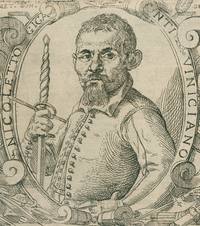|
|
You are not currently logged in. Are you accessing the unsecure (http) portal? Click here to switch to the secure portal. |
Nicoletto Giganti
| Nicoletto Giganti | |
|---|---|
 | |
| Born | 1550-1560 Fossombrone, Italy |
| Died | after 1622 Venice, Italy (?) |
| Occupation |
|
| Nationality | Italian |
| Citizenship | Republic of Venice |
| Patron | Cosimo II de Medici |
| Influenced | Bondì di Mazo (?) |
| Genres | Fencing manual |
| Language | Italian |
| Notable work(s) |
|
Nicoletto Giganti (Niccoletto, Nicolat; 1550s-after 1622[1]) was a 16th – 17th century Italian soldier and fencing master. He was likely born to a noble family in Fossombrone in central Italy,[2] and only later became a citizen of Venice as he stated on the title page of his 1606 treatise. Little is known of Giganti’s life, but in the dedication to his 1606 treatise he counts twenty seven years of professional experience (possibly referring to service in the Venetian military, a long tradition of the Giganti family).[3] The preface to his 1608 treatise describes him as a Mastro d'Arme of the Order of St. Stephen in Pisa, giving some further clues to his career.
In 1606, Giganti published a popular treatise on the use of the rapier (both single and with the dagger) titled Scola, overo teatro ("School or Fencing Hall"). This treatise is structured as a series of progressively more complex lessons, and Tom Leoni opines that this treatise is the best pedagogical work on rapier fencing of the early 17th century.[4] It is also the first treatise to fully articulate the principle of the lunge.
In 1608, Giganti made good the promise in his first book that he would publish a second volume.[5] Titled Libro secondo di Niccoletto Giganti Venetiano, it covers the same weapons as the first as well as rapier and buckler, rapier and cloak, rapier and shield, single dagger, and mixed weapon encounters. This text in turn promises two additional works, on the dagger and on cutting with the rapier, but there is no record of these books ever being published.
Contents
Treatise
| Images | Draft Translation by Aaron Miedema and Ken Harding |
Italian (1606) | German (1619)
by Jan Schäfer |
French (1619)
|
|---|---|---|---|---|
| Text to copy over | Text to copy over |
| Images | Draft Translation by Aaron Miedema and Ken Harding |
Italian (1606) | German (1619)
by Jan Schäfer |
French (1619)
|
|---|---|---|---|---|
| Text to copy over | Text to copy over |
Additional Resources
- Giganti, Nicoletto; Pendragon, Joshua; Terminiello, Piermarco. The 'Lost' Second Book of Nicoletto Giganti (1608): A Rapier Fencing Treatise. Vulpes, 2013. ISBN 978-1909348318
- Leoni, Tom. Venetian Rapier: The School, or Salle. Nicoletto Giganti's 1606 Rapier Fencing Curriculum. Wheaton, IL: Freelance Academy Press, 2010. ISBN 978-0-9825911-2-3
- Mediema, Aaron Taylor. Nicoletto Giganti's the School of the Sword: A New Translation by Aaron Taylor Miedema. Legacy Books Press, 2014. ISBN 978-1927537077
References
- ↑ Leoni, p xii.
- ↑ Lancellotti, Francesco Maria. Quadro letterario degli uomini illustri della città di Fossombrone. In Colucci, Giuseppe. Antichità picene, XXVIII. Fermo, 1796. p 33.
- ↑ Calcaterra, Francesco. Corti e cortigiani nella Roma barocca. Rome, 2012. p 76.
- ↑ Leoni, p xi.
- ↑ This treatise was considered lost for centuries, and as early as 1673 the Sicilian master Pallavicini stated that this second book was never published at all. See Pallavicini, Giuseppe Morsicato. La seconda parte della scherma illustrata. Palermo, 1673. p v.

